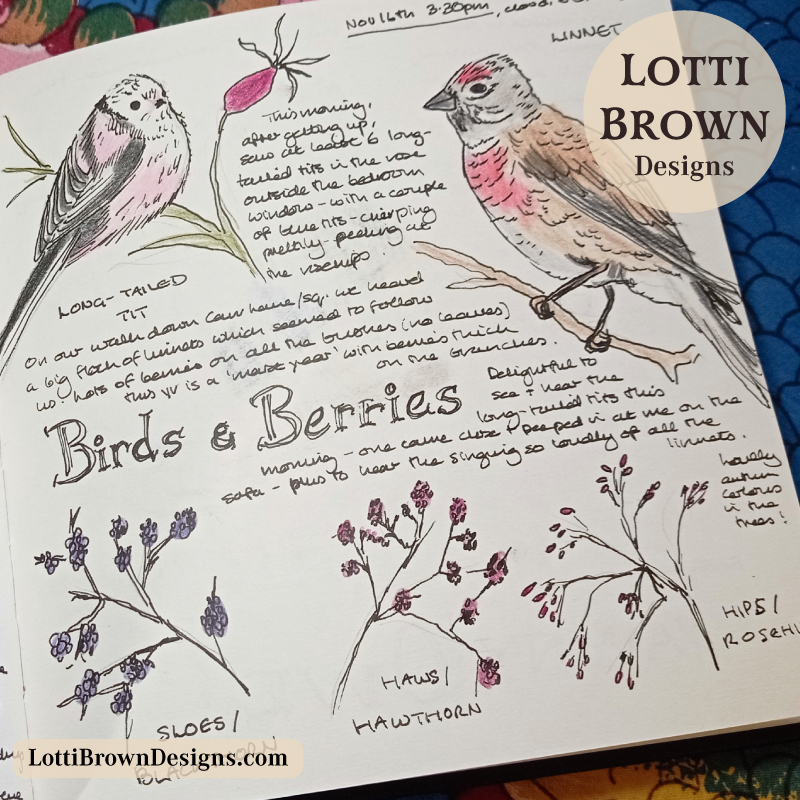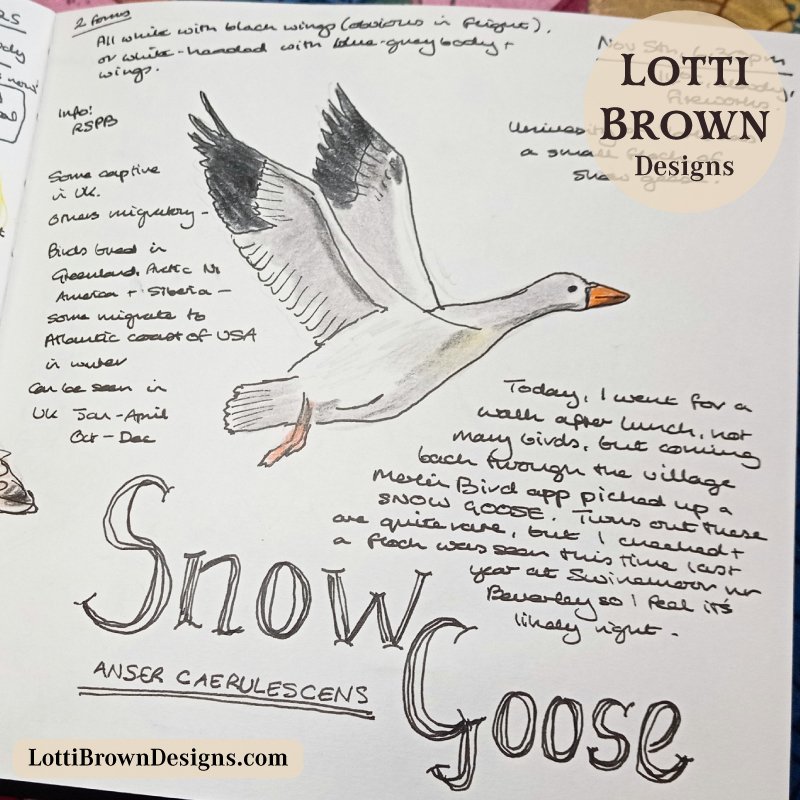*** IMPORTANT - I'm retiring my digital files - SVG/PNG/DXF/EPS - and printables from 31st December 2025 ***
*** Please ensure that you have everything you need - files and/or instructions printed off from the website (find them currently in the ARCHIVES section) - by 31st December 2025 as they will not be available after this date ***

Birds and Berries
A November Nature Journal
- Home
- Nature Journaling
- November Birds & Berries
Winter Birds Arriving in November: A Nature Journal of Berries, Folklore & Seasonal Signs...
November arrives as the leaves turn orange and red and then fall from the trees - and the air starts to grow crisp and chill. The first fingers of frost touch the tips of the grasses as we step out into the darker mornings, a quiet promise of even colder weather to come.
Nature journaling British winter migrant birds...

The branches of the trees and hedgerows are laden with scarlet berries glowing against the bare twigs - it's as if they’re calling out to our winter birds to enjoy the bounty before the freeze sets in.
As we take our morning walk, a flock of merrily chirping linnets seems to follow us as they search the hedgerows for berries...
And long-tailed tits form a small, noisy flock right outside my window as they peck at the rosehips and one actually peeks in at the window at me. A moment of connection to treasure!
 The small resident birds are gathering in flocks now to search for berries as a community - page from my nature journal
The small resident birds are gathering in flocks now to search for berries as a community - page from my nature journalThis year is a "mast year" - a moment when trees and bushes all over Britain provide an abundance of nuts and berries all at once. This phenomenon may be down to the hot dry summer, or even a signal from the network of fungi that interconnects our trees and hedgerows - the hidden mycorrhizal 'wood wide web' beneath our feet.
Country folklore suggests that a heavy berry crop foretells a harsh winter ahead - nature’s way of caring for the birds and wild creatures before the cold begins in earnest.
And right on cue, the migrant birds of winter arrive to take their share of nature's bounty…
Fieldfares & Redwings - Heralds of Winter
As we walk in the mornings, new bird calls echo around the fields now - the redwings and fieldfares have arrived - winter migrant birds who are the heralds of winter. These birds often travel together in mixed flocks, gathering from Scandinavia, northern and eastern Europe and Russia. Their arrival is a sure sign that winter is drawing close...
Once here, mixed groups of between 30 to 200 fieldfares and redwings will roam around the countryside and sweep through berry-rich hedgerows, stripping branches in what's almost a feeding frenzy, before moving on to seek the next feast.
 Fieldfares love red berries in winter - page from my nature journal
Fieldfares love red berries in winter - page from my nature journalThe Anglo-Saxon name for the fieldfare is Fealo-for - the “fallow-farer” - which became the Old English feldefare, meaning “traveller through fields.”
According to British folklore, an early arrival of fieldfares foretells a long winter. In Shropshire, the fieldfare was the Snow Bird, gathering in great flocks before a heavy fall of snow. It was also sometimes called the Storm Bird or Storm Cock for its calls before rain.
 Nature journal drawing of a redwing with its distinctive eye stripe
Nature journal drawing of a redwing with its distinctive eye stripeThe redwing, sometimes known as the Wind Thrush, was also believed to bring winter in its wake. It’s said that the fishermen of Dover and Folkestone once listened awestruck to the rushing, rustling sound of winter redwings crossing the English Channel in the dark - a sound they called the 'herring spear' or 'herring piece'- believing it to be a good omen for abundant catches to come.
Lapwings - Messengers of Storm & Spirit
Across
the fields we hear a different call - the lapwings from Russia have arrived too. They call and tumble dramatically in the skies, giving rise to their common name the 'flopwing'. They join our
native birds who gather in great winter flocks on mudflats to feed on worms and
other hidden creatures.
 Illustration of a lapwing in my nature journal showing its head plume and iridescent feathers
Illustration of a lapwing in my nature journal showing its head plume and iridescent feathersTheir eerie calls of the lapwing were once believed to be the voices of roaming spirits. In Danish folklore, lapwings were the 'old maids' calling out to the 'bachelor' green sandpipers across the bogs and moors.
The lapwing flocks move as one across the lands - a swirling winter cloud of feathers - huddling together for warmth and safety as they seek new unfrozen ground to feed upon. They often arrive with a snowstorm.
The Snow Goose - A Rare Visitor with a Mythic Past
A stroke of luck and a true wanderer appears - a snow goose, honking overhead. Rare in Britain, it feels like a visitor from myth - a shimmering ghost of Arctic lands.
The snow goose was once named Chen hyperborea - the goose of Hyperborea, that legendary northern utopia beyond the mythical realm of Boreas, the god of the freezing North Wind - and has long been linked to winter’s threshold.
To Native American peoples, the snow goose symbolised the passing of the seasons, and a link between the earth and the heavens.
 Nature journal page showing a snow goose in flight, linked to winter folklore and migration
Nature journal page showing a snow goose in flight, linked to winter folklore and migrationIn European folklore, the snow goose belongs to Holda, the ancient nature goddess who could appear as a young maiden or an old woman, and shapeshift into a goose. Flying across the skies wrapped in her goose-feather cloak, the white feathers falling from her cloak fell as snow. In some tales, she shook her goose-down quilt and snow drifted across the land. Holda’s legend is thought to be one of the roots of our fairytale figure Mother Goose.
Inuit and Arctic cultures have a story of the Goose Wife - beautiful women who transform into geese through wearing their goose-skins. They alight in bird form on a lake and their skin is taken by a hunter and they must marry the human man. Only when the Goose Wife can reclaim her goose-skin, is she able to fly away and return to her true life in the Land of the Birds.
The presence of the snow goose in Yorkshire feels still like a whisper of magic and fairytale, a shimmer of ice and enchantment, momentarily made real in our grey November skies.
The First Snow Falls - The Birds Who Told of Winter’s Coming
 Snow falls in late November, foretold by the folklore of the birds!
Snow falls in late November, foretold by the folklore of the birds!And now, deep into the month of November, the first snow of the season drifts across the fields - soft, quiet, and a little wondrous...
It feels as though the folklore of the birds has been whispering its arrival for weeks. The redwings with their restless night flights… the fieldfares gathering in berry-rich hedgerows… the lapwings sweeping low over the mudflats just before a cold snap… even the rare snow goose passing overhead like an enchanted omen from a far northern world.
All of them seem woven into this moment, showing us how the season has shifted. The land takes pause, berries gleam brighter against the whitened hedges, and the birds who foretold the snow become part of its hush...
This moment of quiet steadies us, reminding us that winter isn’t only a season of cold, but also of story, stillness, and small, sustaining beauty.
Berries & Birds - What November Teaches Us
As the berries brighten against the frost and the winter birds gather in their seasonal flocks, November reminds us that the turning of the year is not sharp but soft - a slow unfurling.
These small encounters with birds and berries feel like gentle invitations to pause, to wrap ourselves in a quiet moment, and to just notice the magic of the darker winter months.
Just as the fieldfares and redwings seek nourishment among the hedgerows, we can gather our own handfuls of comfort - moments of stillness, sparks of wonder, the steady rhythm of nature carrying us into winter.
And perhaps, as we fill our journals with these cold-weather treasures, we’ll find that the dark months aren’t empty at all, but full of stories just waiting to be seen.
Nature Journal Prompts for November
- Sketch a berry-laden branch or a visiting winter migrant bird.
- Notice how the light changes this month and write about how it makes you feel.
- Do you hear any winter bird calls? Can you spot flocks of fieldfare, redwing or lapwing?
- Which birds are now gathering in your garden?
- Collect autumn leaves for your nature journal.
If November has taught me anything, it’s that even in the coldest months, there is warmth to be found in noticing. The quiet company of birds, the glow of berries in the hedgerows, the small moments we gather and keep close.
If you'd like more gentle inspiration...
If you’d like more gentle inspiration you might enjoy exploring more seasonal moments in my nature journal...
Or discovering the hand-drawn British birds in my art collection - little pieces of quiet magic for your home.
You can get your free guide to getting started with nature journaling on this page...
I also have a PDF nature journaling course you might like with 20 prompts/exercises for you to try, to inspire you with new ideas and inspiration to develop your own nature journaling style - take a look here...
Further Reading
- Discovering the Folklore of Birds and Beasts - book by Venetia Newell
- The Folk Lore and Provincial Names of British Birds - book by Charles Swainson
- A Dictionary of English and Folk-Names of British Birds - book by H. Kirke Swann
- A History of Birds - book by Simon Wills
- British Birds: Names, Facts, Myths - book by Geoff Green
- Favourite Countryside Birds - book by Eaglemoss Publications Ltd/Dairy Diary
Nature Journaling Course
 Downloadable PDF nature journaling course - 120+ pages, 20 exercises
Downloadable PDF nature journaling course - 120+ pages, 20 exercisesIf you'd like to explore nature journaling more, please consider joining me for my 'Imperfect Nature Journaling' online course - I've called it this to remind us to nature journal for the process of connecting with nature to feel good and not to put pressure on ourselves to create pretty pages which can quickly ruin the fun and the benefits...
It's a series of 20 lessons (in downloadable PDF format) which are great exercises that you can do in your own nature journal to help you try out different ideas and techniques.
This will help you get the most out of your nature journaling sessions and understand what style of nature journaling is the best for you personally.
If this sounds like something you might like, you can find out more about the course here...
If you’d like more nature-inspired stories, folklore, and gentle art from my sketchbook, I’d love to stay in touch.
You can join my newsletter (just below) for monthly reflections, drawing inspiration, and peeks into my newest artworks...
All sent with love from the hedgerows of Yorkshire...
Shall we stay in touch..?
Each month, I share stories from my own nature journal, new art from my studio, and simple seasonal inspiration to help you feel more connected with the turning year...
Recent Articles
-
Birds and Folklore in Britain: A November Nature Journal
Nov 26, 25 04:32 AM
November birds and berries - fieldfares, redwings, lapwings and snow geese with folklore, meaning and nature journal inspiration. -
Elder Tree Meaning and Myths
Nov 24, 25 06:06 AM
Explore the elder tree meaning, symbolism and myths with me as part of the Celtic Tree Calendar... -
Nature Journaling Autumn Fungi & Folklore
Oct 28, 25 05:58 AM
Nature journaling autumn fungi - discover how nature journaling helps you slow down, notice more, and reconnect with the season...
Follow me:
Share this page:




